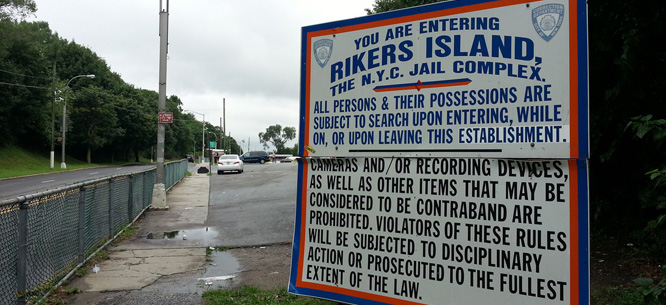In the Hands of “New York’s Boldest”: Cecily McMillan at Rikers
In the Hands of “New York’s Boldest”: Cecily McMillan at Rikers

Rikers Island is a bleak atoll in New York City’s East River, festooned with razor wire, home to some 13,000 prisoners, and run by correctional officers (“New York’s boldest,” as they call themselves) with serious attitude issues. It was not a place I ever expected to find myself. But just over a week ago, I went there to visit my friend and student Cecily McMillan, who, as New York magazine noted last week, “may be the last and most famous of the Occupy Wall Street defendants, more than 2500 of whom were arrested in connection to the protests. . . .” (I discussed Cecily’s case and conviction in two previous Dissent pieces preceding her May 19 sentencing to ninety days at Rikers.)
Cecily is permitted three one-hour visits a week with up to three people at each session. The very dedicated, youthful volunteers in her support group coordinate the list of visitors. So many people want to see her that there is a queue; I was supposed to visit during her first week in jail, but got a call from the Justice for Cecily team asking if I would give up my slot so that Pussy Riot members Maria Alyokhina and Nadya Tolokonnikova could visit. (I was, of course, happy to oblige.) The Pussy Rioters, who know a thing or two about state repression, loved her, describing her as a “political prisoner” and fellow revolutionary, and have called for her release.
My turn to visit came on Friday, May 16, three days before the sentencing. I traveled to Rikers with Columbia University sociologist Todd Gitlin, who offered his own description of the case and of our visit in a recent New Yorker piece, and with filmmaker Nina Davenport, who is making a documentary about Cecily’s case.
It took us a full two and a half hours after our arrival at the prison before we finally reached Cecily. Some of the delay—about a half hour, I’d estimate—was the byproduct of sensible precautions to prevent the smuggling of contraband items into the prison: passing through metal detectors, emptying out pockets, and so forth. The other two hours consisted of being alternately ignored and bullied by correctional staff—“injected, inspected, detected, infected, neglected, and selected,” as in the words of the old Arlo Guthrie song. (Well, maybe not the “injected” part, but all the rest, and repeatedly.) Being academics, we had a language (“total institution,” “ceremonies of degradation”) to distance ourselves from the grim proceedings; other visitors with whom we travelled in tandem that day, mostly black and brown mothers with young children in tow, maybe less so. The process of getting in to seeing a prisoner is not so much about security as it is about reminding a lot of helpless visitors just who is in charge.
The three of us were finally admitted to the brightly lit visiting room in the Rose M. Singer Center, where Cecily is being held, and directed to sit in a row of tiny chairs across a tiny table from another tiny chair where Cecily was led to sit. (The kindergarten furniture may be for the benefit of visiting children, but it has the effect of infantilizing the adults as well.)
The good news is that Cecily, who has had her ups and downs since being sent to Rikers, was in full Cecily mode that day: upbeat, animated, funny, full of plans (and instructions)—all the qualities that make her a good organizer. She looked about as good as one can wearing a bulky shapeless greyish jumpsuit, no make-up, and a hairstyle that might kindly be described as prison-frizzy. She proudly displayed the biceps she had devoted hours to sculpting in the facility’s gym. She had also quit smoking, about which she was less happy.
Yet even at the most carefree moments of the hour-long visit, we were reminded of the arbitrary powers that govern life on the island. As Todd Gitlin noted in his New Yorker piece: “At one point, a guard stepped over, looked down, and told Isserman to uncross his legs. (‘It has something to do with contraband,’ McMillan tried gamely to explain.)” Rules are rules—even when they serve no earthly purpose.
Cecily plans to spend her remaining five or so weeks in prison writing—completing the thesis she was supposed to write under my direction this spring for her master’s degree from the New School, and beginning a memoir about her experience as an Occupy Wall Street activist and a Rikers Island political prisoner. I look forward to reading the book. But mostly I look forward to seeing her a free woman again, out from under the heel of New York’s boldest.
Maurice Isserman teaches history at Hamilton College and is a frequent contributor to Dissent.






